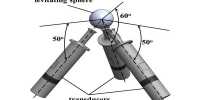They described their discovery in the journal Nanoscale of the Royal Society of Chemistry. It is not the world’s first artificial tongue, but the first single artificial tongue made of two types of nanoscale metal “flavored” – a feature that enhances its taste-testing capabilities and enables it to provide more information in its flavored samples, and fast. Alasdair Clark, A leading author from the University of Glasgow’s School of Engineering said in a statement. “We call it an artificial tongue because it works the same way as a human tongue – it doesn’t detect, like us, individual chemicals that differentiate coffee from apple juice but can easily tell the difference between these complex chemical compounds.”
So, how exactly does it work? It uses the optical properties of gold and aluminum. Sub-microscopic slices of metals are woven together to form a checkerboard pattern. When they are immersed in a liquid, small differences in the way the two metals absorb light enables them to differentiate between different types of whiskey. It can also detect differences in the same whiskey based on its age (i.e. has it aged 12, 15, or 18 years in a barrel?). Interestingly, the device is able to “taste” the difference between drinks with more than 99 percent accuracy. It can’t just tell Glenn Maridoch or your Glen Marncoch or your Laphroaig.
Artfully decorated pieces of gold and aluminum have artificial flavors on the artificial tongue and are about 500 times smaller than their human parts. This could enable authorities to improve the safety of counterfeit alcohol, food safety, and food testing, toxin testing on public roads, as well as – “a real area where a portable, reusable method of tasting will work. Although the study was based on tasting whiskey, the tongue can be used to taste any type of liquid you can think of. If you are among those people who are at risk of poisoning, it can open up a whole new world of fascinating behavior.
















